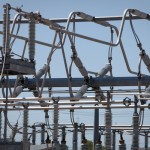How a New Utility Rule Could Mean Less Energy Efficiency for Texas

Photo by Justin Sullivan/Getty Images
Energy efficiency in Texas will become less of a priority under new state rules.
On Friday, the Public Utility Commission, which oversees much of the electricity market in Texas, voted to make energy efficiency less of a priority in the power-hungry state.
While Texas’ population and industry is booming, not enough new power generation is coming on line to meet energy needs during times of peak demand.
In 1999, the Texas legislature passed Senate Bill 7, which mandated that private utilities meet ten percent of their new demand through energy efficiency programs. That incentivized companies to provide energy efficiency discounts for things like insulation, and window and air conditioner upgrades to their customers. That was paid for by a small charge on every consumer’s bill. Those upgrades would also result in them using less power, and paying lower power bills.
Because of the initial program’s success, the lege took things a step further in 2007 with higher energy efficiency requirements and bonuses. Currently, private power companies must anwer for twenty-five percent of their new demand with reductions in use from energy efficiency upgrades. That number will grow to up to thirty percent next year.
Now that’s likely to change. The new rule by the Public Utility Commission (PUC) puts a cap on how much consumers can be charged for the efficiency program. And it exempts some industrial customers completely.
“Depending on where you live, it’s going to reduce the amount of money to get incentives from your utility to help you do affordable energy-efficiency upgrades,” says David Power of Public Citizen Texas, an environmental group.
In the rule (a whopping 298-pager), the PUC says they support the cap because it helps to “control the rate impact on residential customers as much as possible.” The commission believes the new rule also “allows the utilities more flexibility due to the varying characteristics of the commercial customer classes, while still limiting the total impact on commercial customers.”
“Multiple studies have shown that this [energy efficiency] is the most cost-effective manner that they can reduce the increase in demand,” Power says, “and [the PUC] has chosen instead to raise price caps and incentivize more generation.”
The price caps Power is referring to are the maximum amount private utilities can charge when the Texas grid gets stretched. They’re known in the industry as “offer caps.” They are typically the times when generators make a lot of their profits. Earlier this year, the peak price was raised by the PUC from $3,000 to $4,500, and they’re considering taking it all the way up to $9,000. Public Citizen and other groups argued to the commission that if the amount that power companies can charge was going to go up, then the amount allocated to energy efficiency programs should go up, too.
But with their vote Friday, it’s clear the Public Utility Commission disagrees.
“The commission declines to adopt a higher cost cap on the basis of assisting utilities in achieving their goals, as a majority of utilities are exceeding the goals, and the proposed rule provides for a good cause exception to the cost cap that will assist utilities that are unable to meet their goals under the cost cap,” the commission says in the new rule.
Texas ranked 33rd in the nation last year for energy efficiency, according to a study by the American Council for an Energy-Efficient Economy. “This new rule-making puts us even farther back,” Power says. Power and his group are calling on the upcoming legislature to reverse the decision.


